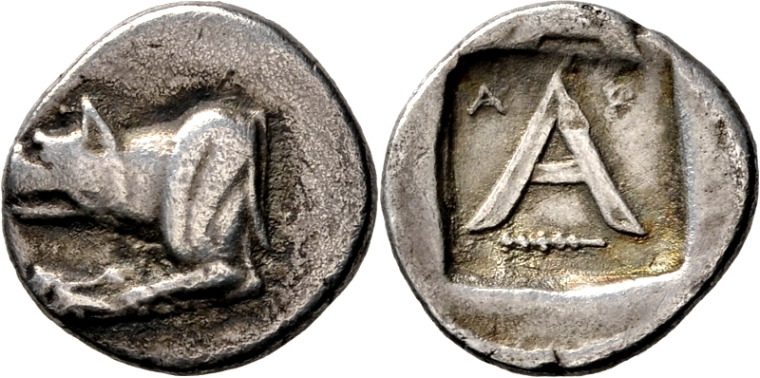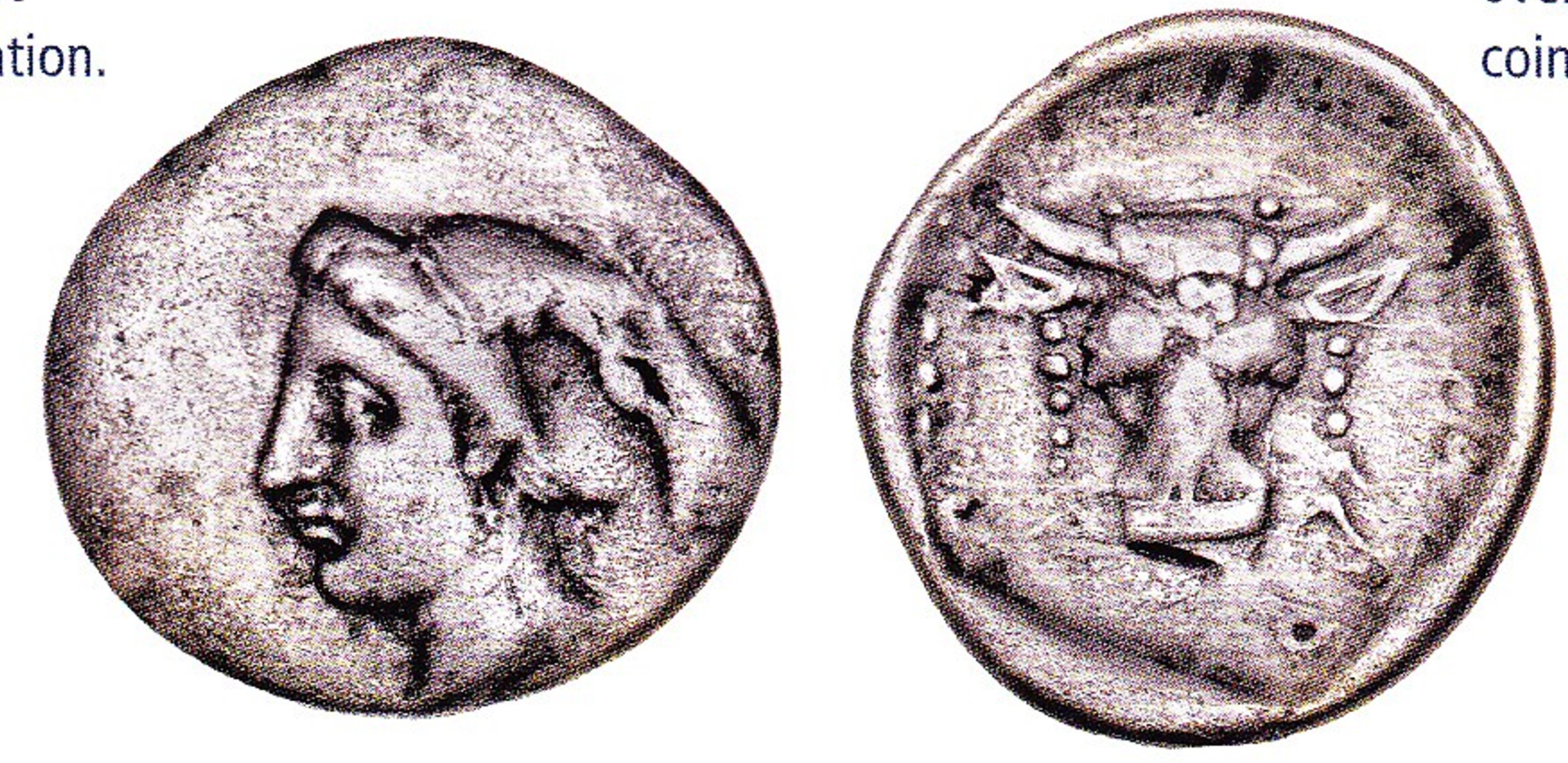2108 - Polyrhenium (hemidrachm Dictynna/bull) over Argos (wolf/A) (MacDonald coll., 117)
From SILVER
330 BCE - 270 BCE
Images
Overstruck variety Traces of the overstruck variety
Traces of the overstruck variety

Argos (under Phalasarna).jpg [1]
Location/history
| Private collection(s)Private collection(s) ᵖ: | D. MacDonald collection, n° 117 |
Overstriking coin
Description
| ObverseInscription or printing placed on the obverse.: | Head of Artemis Diktynna left, wearing triple pendant earring, pearl necklace and with her hair bound up and tied into a sakkos ornamented with stars at the back. | ReverseInscription or printing placed on the reverse.: | Bull's head facing, with fillets hanging from its horns |
Mint and issuing power
| MintIdentifies the place of manufacture or issue of a numismatic object.: | Polyrhenium | Ancient regionAncient region. | Crete | Modern countryModern country: Greece | AuthorityIdentifies the issuing power. The authority can be "pretended" when the name or the portrait of X is on the coin but he/she was not the issuing power. It can also be "uncertain" when there is no mention of X on the coin but he/she was the issuing power according to the historical sources: |
Chronology
| FromIdentifies the initial date in a range assigned in a numismatic context. 330 BCE toIdentifies the final date in a range assigned in a numismatic context.. 270 BCE | Hellenistic 323-30 BC |
Physical description
| MetalThe physical material (usually metal) from which an object is made.: Silver |
WeightWeight of the numismatic object (in grams). in grams: 2.292.29 g <br />2,290 mg <br /> | DenominationTerm indicating the value of a numismatic object. Examples: tetradrachm, chalkous, denarius.: hemidrachm |
AxisDescribes the directional relationship between the obverse and reverse of a numismatic object.: 33 mm <br />0.3 cm <br /> |
| StandardStandard.: Aeginetic | |||
References
| Coin referenceReference of the Coin: | MacDonald 2009, n° 117 | Coin series referenceReference to coin series study: | Svoronos 18901Svoronos 1890, p. 278, n° 15, pl. XXVI, n° 4, Le Rider 19662Le Rider 1966, p. 116-117, n° 7, pl. XXVIII, n° 38 and pl. XXIX, n° 1-9 (same dies), MacDonald 20093MacDonald 2009, n° 117 |
| Coin series web referenceCoin series web references: | |||
Overstruck type
Description
| ObverseInscription or printing placed on the obverse.: | Forepart of wolf left. In left field, Δ (visible on obverse: paw and leg). | ReverseInscription or printing placed on the reverse.: | A in incuse square with two deeper incuses in upper part. (visible on reverse: large A, P). |
Mint and issuing power
| MintIdentifies the place of manufacture or issue of a numismatic object. ᵖ: | Argos | Ancient regionAncient region. ᵖ | Peloponnesus | Modern countryModern country: Greece | AuthorityIdentifies the authority in whose name (explicitly or implicitly) a numismatic object was issued. ᵖ: |
Chronology
| FromIdentifies the initial date in a range assigned in a numismatic context. 375 BCE toIdentifies the final date in a range assigned in a numismatic context.. 320 BCE | Classical 480-323 BC |
Physical description
| DenominationTerm indicating the value of a numismatic object. Examples: tetradrachm, chalkous, denarius. ᵖ: | hemidrachm |
References
| Coin type referenceReference to coin series study ᵖ: | HGC 54HGC 5, n° 668 | ||
| Coin series web reference overstruckCoin series web references overstruck: | |||
Additional data
| Frequency of overstrikesFrequency of overstrikes: | frequent | Level of confidenceLevel of confidence of the identification: | sure |
| RemarksRemarks: | |||
References
- ^ Svoronos, Ioannes N. (1890), Numismatique de Crète ancienne, accompagnée de l'histoire, la géographie et la mythologie de l'île. Première partie, description des monnaies, 2 vol., Macon, Impr. Protat frères.
- ^ Le Rider, Georges (1966), Monnaies crétoises du Ve au Ier siècle av. J.-C., Paris, Geuthner, 345 p. and 42 pl.
- ^ MacDonald, David (2009), Overstruck Greek coins: studies in Greek chronology and monetary theory, Whitman Publishing, Atlanta.
- ^ Hoover, Oliver D. (2011), Handbook of Greek Coins 5. Coins of the Peloponnesos, Achaia, Phleiasia, Sikyonia, Elis, Triphylia, Messenia, Lakonia, Argolis, and Arkadia, Sixth to First Centuries BC, Lancaster (PA), 2011.

